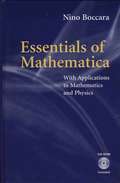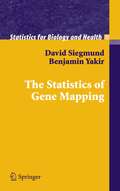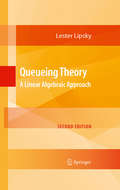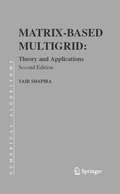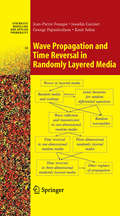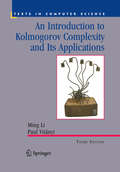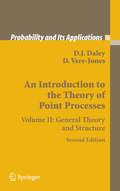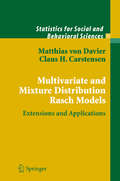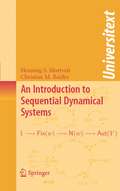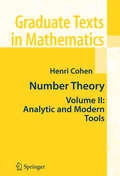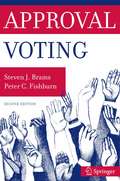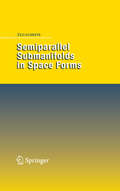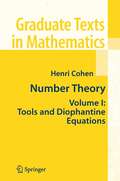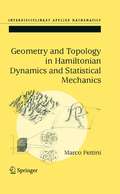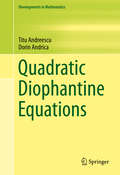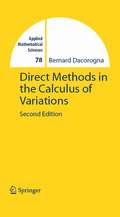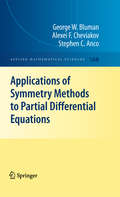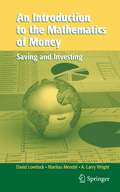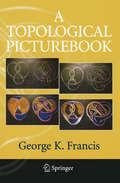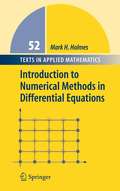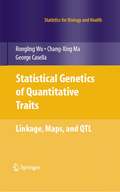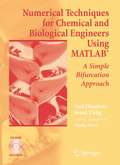- Table View
- List View
Essentials of Mathematica: With Applications to Mathematics and Physics
by Nino BoccaraThis book teaches how to use Mathematica to solve a wide variety of problems in mathematics and physics. It is based on the lecture notes of a course taught at the University of Illinois at Chicago to advanced undergrad and graduate students. The book is illustrated with many detailed examples that require the student to construct meticulous, step-by-step, easy to read Mathematica programs. The first part, in which the reader learns how to use a variety of Mathematica commands, contains examples, not long explanations; the second part contains attractive applications.
The Statistics of Gene Mapping (Statistics for Biology and Health)
by David Siegmund Benjamin YakirThis book details the statistical concepts used in gene mapping, first in the experimental context of crosses of inbred lines and then in outbred populations, primarily humans. It presents elementary principles of probability and statistics, which are implemented by computational tools based on the R programming language to simulate genetic experiments and evaluate statistical analyses. Each chapter contains exercises, both theoretical and computational, some routine and others that are more challenging. The R programming language is developed in the text.
Queueing Theory: A Linear Algebraic Approach
by Lester LipskyQueueing Theory deals with systems where there is contention for resources, but the demands are only known probabilistically. This book can be considered to be a monograph or a textbook, and thus is aimed at two audiences: those who already know Queueing Theory but would like to know more of the Linear Algebraic Approach; and as a rst course for students who don't already have a strong background in probability, and feel more comfortable with algebraic arguments. Also, the equations are well suited to easy computation. In fact, there is much discussion on how various properties can be easily computed in any language that has automatic matrix operations (e.g., MATLAB). To help with physical insight, there are over 80 gures, numerous examples and exercises distributed throughout the book. There are, perhaps 50 books on QT that are available today, and most practitioners have several of them on their shelves. This book would be a good addition, as well as a good supplement to another text. This second edition has been updated throughout including a new chapter on Semi Markov Processes and new material on matrix representations of distributions and Power-tailed distribution. Lester Lipsky is a Professor in the Department of Computer Science and Engineering at the University of Connecticut.
Bounded Analytic Functions (Graduate Texts in Mathematics #236)
by John GarnettThis book is an account of the theory of Hardy spaces in one dimension, with emphasis on some of the exciting developments of the past two decades or so. The last seven of the ten chapters are devoted in the main to these recent developments. The motif of the theory of Hardy spaces is the interplay between real, complex, and abstract analysis. While paying proper attention to each of the three aspects, the author has underscored the effectiveness of the methods coming from real analysis, many of them developed as part of a program to extend the theory to Euclidean spaces, where the complex methods are not available.
Matrix-Based Multigrid: Theory and Applications (Numerical Methods and Algorithms #2)
by Yair ShapiraMatrix-Based Multigrid introduces and analyzes the multigrid approach for the numerical solution of large sparse linear systems arising from the discretization of elliptic partial differential equations. Special attention is given to the powerful matrix-based-multigrid approach, which is particularly useful for problems with variable coefficients and nonsymmetric and indefinite problems. This book can be used as a textbook in courses in numerical analysis, numerical linear algebra, and numerical PDEs at the advanced undergraduate and graduate levels in computer science, math, and applied math departments. The theory is written in simple algebraic terms and therefore requires preliminary knowledge only in basic linear algebra and calculus.
Linking and Aligning Scores and Scales (Statistics for Social and Behavioral Sciences)
by Mary Pommerich Paul W. Holland Neil J. DoransIn this book, experts in statistics and psychometrics describe classes of linkages, the history of score linkings, data collection designs, and methods used to achieve sound score linkages. They describe and critically discuss applications to a variety of domains. They define what linking is, to distinguish among the varieties of linking and to describe different procedure for linking. Furthermore, they convey the complexity and diversity of linking by covering different areas of linking and providing diverse perspectives.
Wave Propagation and Time Reversal in Randomly Layered Media (Stochastic Modelling and Applied Probability #56)
by Jean-Pierre Fouque Josselin Garnier G. Papanicolaou Knut SolnaThe content of this book is multidisciplinary by nature. It uses mathematical tools from the theories of probability and stochastic processes, partial differential equations, and asymptotic analysis, combined with the physics of wave propagation and modeling of time reversal experiments. It is addressed to a wide audience of graduate students and researchers interested in the intriguing phenomena related to waves propagating in random media. At the end of each chapter there is a section of notes where the authors give references and additional comments on the various results presented in the chapter.
An Introduction to Kolmogorov Complexity and Its Applications (Texts in Computer Science)
by Ming Li Paul M.B. Vitányi“The book is outstanding and admirable in many respects. ... is necessary reading for all kinds of readers from undergraduate students to top authorities in the field.” Journal of Symbolic Logic Written by two experts in the field, this is the only comprehensive and unified treatment of the central ideas and applications of Kolmogorov complexity. The book presents a thorough treatment of the subject with a wide range of illustrative applications. Such applications include the randomness of finite objects or infinite sequences, Martin-Loef tests for randomness, information theory, computational learning theory, the complexity of algorithms, and the thermodynamics of computing. It will be ideal for advanced undergraduate students, graduate students, and researchers in computer science, mathematics, cognitive sciences, philosophy, artificial intelligence, statistics, and physics. The book is self-contained in that it contains the basic requirements from mathematics and computer science. Included are also numerous problem sets, comments, source references, and hints to solutions of problems. New topics in this edition include Omega numbers, Kolmogorov–Loveland randomness, universal learning, communication complexity, Kolmogorov's random graphs, time-limited universal distribution, Shannon information and others.
An Introduction to the Theory of Point Processes: Volume II: General Theory and Structure (Probability and Its Applications)
by D.J. Daley David Vere-JonesThis is the second volume of the reworked second edition of a key work on Point Process Theory. Fully revised and updated by the authors who have reworked their 1988 first edition, it brings together the basic theory of random measures and point processes in a unified setting and continues with the more theoretical topics of the first edition: limit theorems, ergodic theory, Palm theory, and evolutionary behaviour via martingales and conditional intensity. The very substantial new material in this second volume includes expanded discussions of marked point processes, convergence to equilibrium, and the structure of spatial point processes.
Multivariate and Mixture Distribution Rasch Models: Extensions and Applications (Statistics for Social and Behavioral Sciences)
by Matthias Davier Claus H. CarstensenThis book examines extensions of the Rasch model, one of the most researched and applied models in educational research and social science. This collection contains 22 chapters by some of the most renowned international experts in the field. They cover topics ranging from general model extensions to applications in fields as diverse as cognition, personality, organizational and sports psychology, and health sciences and education.
An Introduction to Sequential Dynamical Systems (Universitext)
by Henning Mortveit Christian ReidysThis introductory text to the class of Sequential Dynamical Systems (SDS) is the first textbook on this timely subject. Driven by numerous examples and thought-provoking problems throughout, the presentation offers good foundational material on finite discrete dynamical systems, which then leads systematically to an introduction of SDS. From a broad range of topics on structure theory - equivalence, fixed points, invertibility and other phase space properties - thereafter SDS relations to graph theory, classical dynamical systems as well as SDS applications in computer science are explored. This is a versatile interdisciplinary textbook.
Number Theory: Volume II: Analytic and Modern Tools (Graduate Texts in Mathematics #240)
by Henri CohenThis book deals with several aspects of what is now called "explicit number theory." The central theme is the solution of Diophantine equations, i.e., equations or systems of polynomial equations which must be solved in integers, rational numbers or more generally in algebraic numbers. This theme, in particular, is the central motivation for the modern theory of arithmetic algebraic geometry. In this text, this is considered through three of its most basic aspects. The local aspect, global aspect, and the third aspect is the theory of zeta and L-functions. This last aspect can be considered as a unifying theme for the whole subject.
Approval Voting
by Steven Brams Peter C. FishburnThis book presents a simple and logical potential electoral reform. Under this system, voters may vote for, or approve of, as many candidates as they like in multicandidate elections. Among the many benefits of approval voting are its propensity to elect the majority candidate, its relative invulnerability to insincere or strategic voting, and a probable increase in voter turnout.
Semiparallel Submanifolds in Space Forms
by Ülo LumisteQuite simply, this book offers the most comprehensive survey to date of the theory of semiparallel submanifolds. It begins with the necessary background material, detailing symmetric and semisymmetric Riemannian manifolds, smooth manifolds in space forms, and parallel submanifolds. The book then introduces semiparallel submanifolds and gives some characterizations for their class as well as several subclasses. The coverage moves on to discuss the concept of main symmetric orbit and presents all known results concerning umbilic-like main symmetric orbits. With more than 40 published papers under his belt on the subject, Lumiste provides readers with the most authoritative treatment.
Number Theory: Volume I: Tools and Diophantine Equations (Graduate Texts in Mathematics #239)
by Henri CohenThe central theme of this book is the solution of Diophantine equations, i.e., equations or systems of polynomial equations which must be solved in integers, rational numbers or more generally in algebraic numbers. This theme, in particular, is the central motivation for the modern theory of arithmetic algebraic geometry. In this text, this is considered through three of its most basic aspects. The book contains more than 350 exercises and the text is largely self-contained. Much more sophisticated techniques have been brought to bear on the subject of Diophantine equations, and for this reason, the author has included five appendices on these techniques.
Geometry and Topology in Hamiltonian Dynamics and Statistical Mechanics (Interdisciplinary Applied Mathematics #33)
by Marco PettiniThis book covers a new explanation of the origin of Hamiltonian chaos and its quantitative characterization. The author focuses on two main areas: Riemannian formulation of Hamiltonian dynamics, providing an original viewpoint about the relationship between geodesic instability and curvature properties of the mechanical manifolds; and a topological theory of thermodynamic phase transitions, relating topology changes of microscopic configuration space with the generation of singularities of thermodynamic observables. The book contains numerous illustrations throughout and it will interest both mathematicians and physicists.
Quadratic Diophantine Equations (Developments in Mathematics #40)
by Titu Andreescu Dorin AndricaThis text treats the classical theory of quadratic diophantine equations and guides the reader through the last two decades of computational techniques and progress in the area. The presentation features two basic methods to investigate and motivate the study of quadratic diophantine equations: the theories of continued fractions and quadratic fields. It also discusses Pell’s equation and its generalizations, and presents some important quadratic diophantine equations and applications. The inclusion of examples makes this book useful for both research and classroom settings.
Direct Methods in the Calculus of Variations (Applied Mathematical Sciences #78)
by Bernard DacorognaThis book is developed for the study of vectorial problems in the calculus of variations. The subject is a very active one and almost half of the book consists of new material. This is a new edition of the earlier book published in 1989 and it is suitable for graduate students. The book has been updated with some new material and examples added. Applications are included.
Physics of Classical Electromagnetism
by Minoru FujimotoThis book is unique because unlike others on the subject that focus on mathematical arguments, this volume emphasizes the original field concept, aiming at objectives in modern information technology. Written primarily for undergraduate students of physics and engineering, this book serves as a useful reference for graduate students and researchers too. With concise introductory arguments for the physics of electromagnetism, this book covers basic topics including the nature of space-time-dependent radiations in modern applications.
Applications of Symmetry Methods to Partial Differential Equations (Applied Mathematical Sciences #168)
by George W. Bluman Alexei F. Cheviakov Stephen AncoThis is an acessible book on the advanced symmetry methods for differential equations, including such subjects as conservation laws, Lie-Bäcklund symmetries, contact transformations, adjoint symmetries, Nöther's Theorem, mappings with some modification, potential symmetries, nonlocal symmetries, nonlocal mappings, and non-classical method. Of use to graduate students and researchers in mathematics and physics.
An Introduction to the Mathematics of Money: Saving and Investing
by David Lovelock Marilou Mendel Arthur L. WrightThis is an undergraduate textbook on the basic aspects of personal savings and investing with a balanced mix of mathematical rigor and economic intuition. It uses routine financial calculations as the motivation and basis for tools of elementary real analysis rather than taking the latter as given. Proofs using induction, recurrence relations and proofs by contradiction are covered. Inequalities such as the Arithmetic-Geometric Mean Inequality and the Cauchy-Schwarz Inequality are used. Basic topics in probability and statistics are presented. The student is introduced to elements of saving and investing that are of life-long practical use. These include savings and checking accounts, certificates of deposit, student loans, credit cards, mortgages, buying and selling bonds, and buying and selling stocks.The book is self contained and accessible. The authors follow a systematic pattern for each chapter including a variety of examples and exercises ensuring that the student deals with realities, rather than theoretical idealizations. It is suitable for courses in mathematics, investing, banking, financial engineering, and related topics.
A Topological Picturebook
by George K. FrancisPraise for George Francis's A Topological Picturebook: Bravo to Springer for reissuing this unique and beautiful book! It not only reminds the older generation of the pleasures of doing mathematics by hand, but also shows the new generation what ``hands on'' really means. - John Stillwell, University of San Francisco The Topological Picturebook has taught a whole generation of mathematicians to draw, to see, and to think. - Tony Robbin, artist and author of Shadows of Reality: The Fourth Dimension in Relativity, Cubism, and Modern Thought The classic reference for how to present topological information visually, full of amazing hand-drawn pictures of complicated surfaces. - John Sullivan, Technische Universitat Berlin A Topological Picturebook lets students see topology as the original discoverers conceived it: concrete and visual, free of the formalism that burdens conventional textbooks. - Jeffrey Weeks, author of The Shape of Space A Topological Picturebook is a visual feast for anyone concerned with mathematical images. Francis provides exquisite examples to build one's "visualization muscles". At the same time, he explains the underlying principles and design techniques for readers to create their own lucid drawings. - George W. Hart, Stony Brook University In this collection of narrative gems and intriguing hand-drawn pictures, George Francis demonstrates the chicken-and-egg relationship, in mathematics, of image and text. Since the book was first published, the case for pictures in mathematics has been won, and now it is time to reflect on their meaning. A Topological Picturebook remains indispensable. - Marjorie Senechal, Smith College and co-editor of the Mathematical Intelligencer
Introduction to Numerical Methods in Differential Equations (Texts in Applied Mathematics #52)
by Mark H. HolmesThis book shows how to derive, test and analyze numerical methods for solving differential equations, including both ordinary and partial differential equations. The objective is that students learn to solve differential equations numerically and understand the mathematical and computational issues that arise when this is done. Includes an extensive collection of exercises, which develop both the analytical and computational aspects of the material. In addition to more than 100 illustrations, the book includes a large collection of supplemental material: exercise sets, MATLAB computer codes for both student and instructor, lecture slides and movies.
Statistical Genetics of Quantitative Traits: Linkage, Maps and QTL (Statistics for Biology and Health)
by Rongling Wu Changxing Ma George CasellaThis book introduces the basic concepts and methods that are useful in the statistical analysis and modeling of the DNA-based marker and phenotypic data that arise in agriculture, forestry, experimental biology, and other fields. It concentrates on the linkage analysis of markers, map construction and quantitative trait locus (QTL) mapping, and assumes a background in regression analysis and maximum likelihood approaches. The strength of this book lies in the construction of general models and algorithms for linkage analysis, as well as in QTL mapping in any kind of crossed pedigrees initiated with inbred lines of crops.
Numerical Techniques for Chemical and Biological Engineers Using MATLAB®: A Simple Bifurcation Approach
by Said S.E.H. Elnashaie Frank UhligThis interdisciplinary book presents numerical techniques needed for chemical and biological engineers using Matlab. The book begins by exploring general cases, and moves on to specific ones. The text includes a large number of detailed illustrations, exercises and industrial examples. The book provides detailed mathematics and engineering background in the appendixes, including an introduction to Matlab. The text will be useful to undergraduate students in chemical/biological engineering, and in applied mathematics and numerical analysis.
